|
|
|
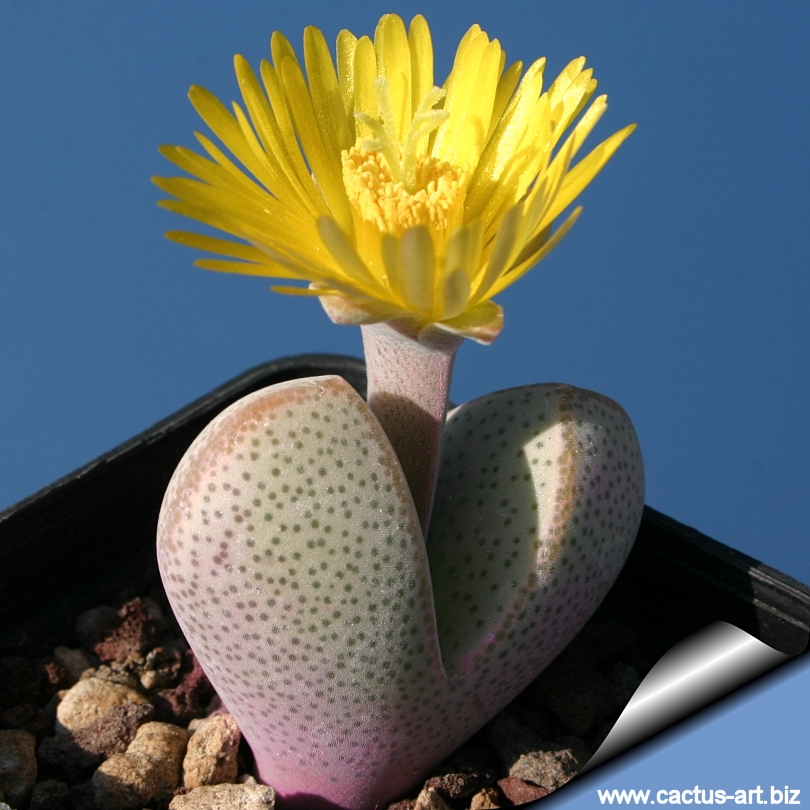
Unsurprisingly, these small plants with velvety surface due to hair-like
papillae
have the common name “flowering stone”.
|
|
Description: Dinteranthus microspermus is a small
stemless succulent that grows above ground and not markedly buried after
the manner of D. vanzylii.
It is usually solitary or few
branched, but subspecies 'puberulus'
forms small compact groups with 3-7 branches up 2 to 3 cm high, each
with a single leaf-pair in the resting state.
Plant body (Leaf-pairs): The plant has only pairs of boat-shaped,
leaves about 2,5 cm long and broad with an inconspicuous keel, they are
connate (united) to their length for 1/3 to 2/3 with a wide gap. Leaves
are trigonus with convex sides as seen from above and semi-oval to
semi-orbicular in side view. The leaves are chalky white suffused with
violet or reddish, they are covered with green dots and without
'windows'. The epidermis of subs. 'microspermus' is
galbrous while in subs. 'puberulus' the surface is
green dotted and velvety due to hair-like papillae. The outer epidermal
walls with a layer of crystal sand (not visible to the naked eyes) has a
characteristically glittering shine.
Flowers: Solitary, yellow or whitish often tipped with reddish,
filaments basally white erect, staminodes absent,
Fruit: The fruit is a 6-10 locular capsule with broadly winged
valves.
|
|
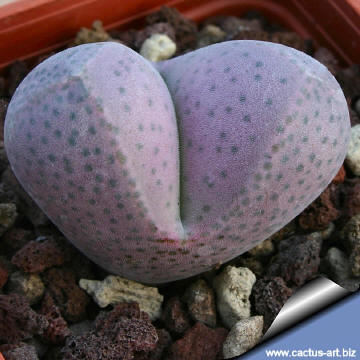 |
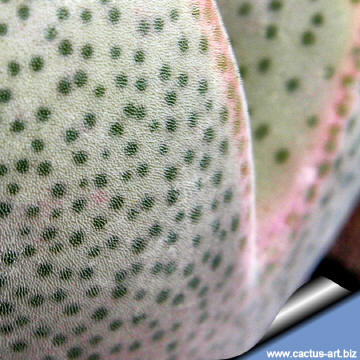 |
|
. |
|
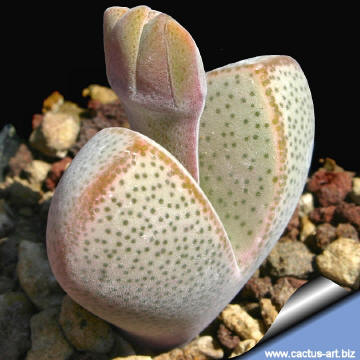 |
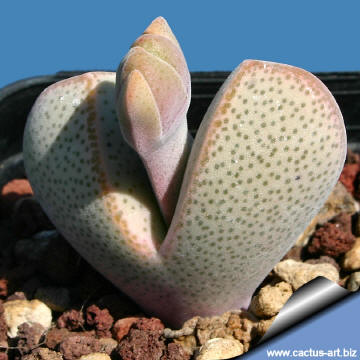 |
|
Remarks: The strange appearance of Dinteranthus
have made them very popular in succulent collections. They
are similar in habit to Lithops
but grows above ground (only D. vanzily is
partly subterranean like Lithops with the
top of each leaf tip exposed above soil). They are also called
mimicry plants as they show a
striking similarity to their background rocks and are difficult to
detect when not in flower. The Dinteranthus have a pebbly
look and are commonly known as pebble
plants or living stones; each species is associated with one particular
type of rock formation and occurs nowhere else. This camouflage also
reduces the need for chemical defences against herbivores.
|
|
Photo of conspecific taxa, varieties, forms and cultivars of
Dinteranthus microspermus.
Advertising
|
|
|
|
Family: Mesebrianthemaceae (Aizoaceae)
Scientific name:
Dinteranthus
microspermus (Dinter & Derenb.) Schwant. subsp. puberulus
(N.E. Br.) Sauer
Origin:
Namibia, Namaqualand, Northern cape, South
Africa. (the ssp. 'puberulus' is geografically separated
and occurs south east of the area of D. microspermus in
the Kenhardt district)
Habitat:
Grows
in quartz slopes, in summer raining areas. They both
in colour and shape, resemble the stones and pebbles found in their
natural habitat. The form and colour of the
Dinteranthus
have developed in order to allow them to live in the harsh conditions of
their natural environment where they are able to stand extended periods
of drought.
Common English Names include: Stone plant, Green stone
plant, Living stone.
Synonyms:
- Mesembryanthemum microspermum
Dinter & Derenb
- Dinteranthus puberulus
N.E.Brown
In: G.C. 1928:472
- Dinteranthus punctatus
L.Bolus
In: NM 1929:67
Etymology: The genus has been
named after K. Dinter 1868-1945, German Government botanist
working in Namibia 1897-1935.
The species name “microspermus” derives from Greek
'mikros', small; and
Greek 'sperma', seed.
The subspecies name comes from Latin “puberulum” with tiny
hairs, finely hairy, downy; (From
pubes youth, men; hair that appears at puberty) for the pubescent stems.
|
|
|
|
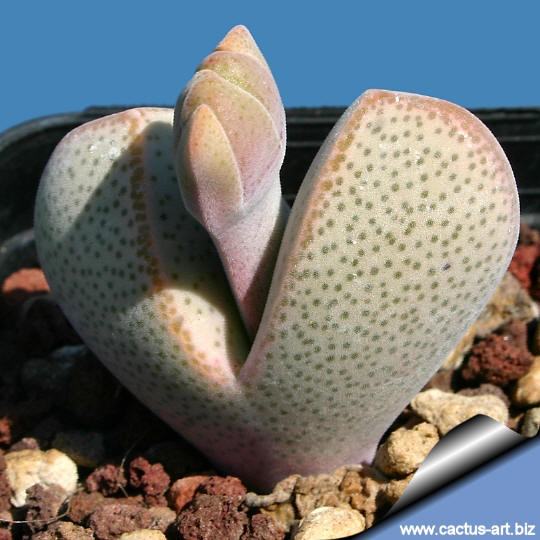
Cultivation: Dinteranthus are summer growing species
with dry rest period over winter
but they do not shows an
apparent dormant season like Lithops. Easy to
grow they need a very open mineral, fast draining mix with little
compost and a high degree of grit, coarse sand, small lava gravel or
pebbles. Give them the maximum amount of light you are able to give
them, but care should be taken about exposing them to the full blast of
the sun rays in summer (The
only exception to this is seedlings in their first year that enjoy a
shades place) . Such tiny plants can easily
get scorched or broiled and their appearance spoiled (this may not
matter in the wild, where the Dinteranthus have probably
shrunk into the ground and becomes covered with sands).
The basic cultivation routine is: Gives some water all year, more in
Spring and again in autumn. Keep rather dry during coldest winter month
and start watering regularly after the old leaves completely dry.
(Usually late March or Early April) Water freely during the growing
season, soak the compost fully but allow it to dry out between
waterings. Some growers fertilize frequently, some hardly ever. Nearly
all problems occur as a result of overwatering and poor ventilation
especially when weather conditions are dull and cool or very humid. If
too much water is supplied the plants will grow out of character, bloat,
split and rot. Keep them in small pots as solitary clumps or as colonies
in large, shallow terracotta seed pans.
When in doubt DON'T
WATER. Where the resting season is in the winter and central heating
gives very dry air in the home, give a light top spray once a week to
simulate the desert dew and prevent excessive dehydration. Overwinter
them preferably not below 5° C (but they endure some freeze if very
dry).
Note: After flowering in the summer and extending through
winter
season the plant doesn’t need
watering, but they will still be
growing, the new
bodies will be increasing in size
extracting
water from the outer
succulent leaves, allowing them to
shrivel away. In fact the plant in this
time extracts
water and
nutrient stored in the outer
succulent leaves, allowing them to
dehydrate relocating the water to the
rest of the plant and to the new leaves that form during this period
until the old leaves are reduced to nothing more than "thin papery
shells".
Propagation: From seed
(very small) or by dividing older clumps. Slow growing for a mesemb.

 |
|